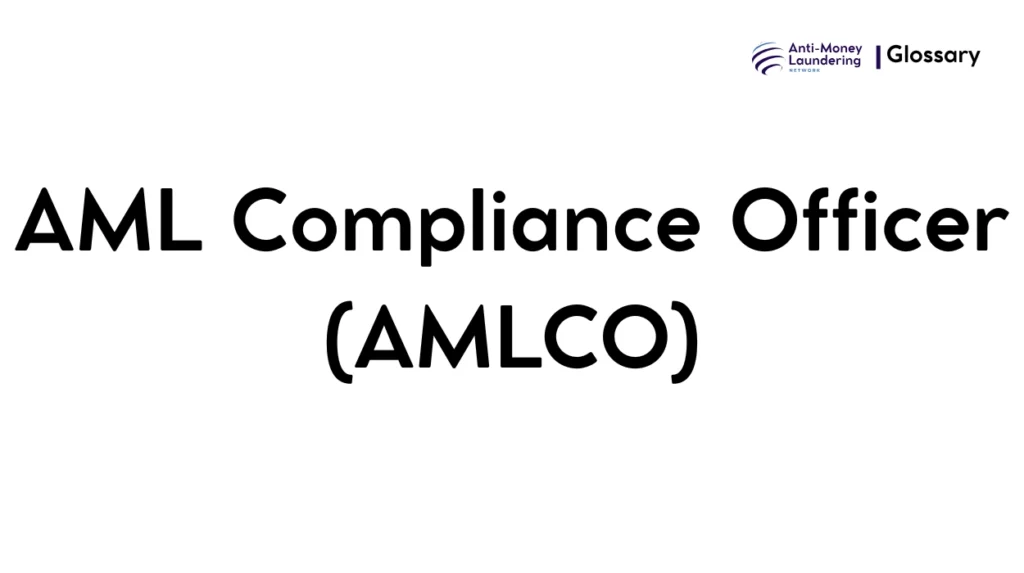Definition
An Anti-Money Laundering Compliance Officer (AMLCO) is a designated professional within a financial institution or regulated entity responsible for ensuring the organization complies with laws and regulations aimed at preventing money laundering, terrorist financing, and related financial crimes. The AMLCO develops, implements, and monitors the institution’s AML policies, procedures, and controls, acting as a central figure in mitigating risks related to financial crime.
Purpose and Regulatory Basis
The AMLCO’s core purpose is to safeguard financial institutions from the illicit activities of money laundering and terrorist financing by ensuring compliance with key AML regulatory frameworks. These include globally recognized standards such as the Financial Action Task Force (FATF) recommendations, regional laws like the USA PATRIOT Act, the Bank Secrecy Act (BSA) in the United States, and the European Union’s Anti-Money Laundering Directives (AMLD).
The AMLCO plays a critical role in protecting the integrity and stability of financial markets by preventing institutions from being exploited by criminals. Failure to comply with AML laws can result in severe penalties, including fines and reputational damage, highlighting why this role is fundamental to institutional compliance and risk management.
When and How it Applies
AMLCOs are typically appointed in financial institutions such as banks, credit unions, insurance companies, and investment firms, as well as non-financial businesses subject to AML regulations, like real estate, casinos, and legal firms.
Common triggers for AMLCO involvement include onboarding new clients with high-risk profiles such as politically exposed persons (PEPs), monitoring suspicious transactions, and ensuring comprehensive reporting to relevant authorities. For example, if suspicious activity is detected in transactional monitoring software, the AMLCO coordinates investigations and filing of Suspicious Activity Reports (SARs) with regulators.
Types or Variants
While the core role of the AMLCO is consistent, titles and specific functions might differ across jurisdictions and institutions:
- Money Laundering Reporting Officer (MLRO): Common in the UK and some Commonwealth countries, focusing largely on receiving and reporting suspicious activities.
- Nominated Officer: Another term used interchangeably with AMLCO or MLRO in some regions.
- BSA Officer: Refers specifically to the AML compliance officer under the Bank Secrecy Act framework in the US.
- Deputy AML Compliance Officer (DAMLCO): Supports the AMLCO in larger institutions or funds, assisting in operational compliance and oversight.
Procedures and Implementation
To comply with AML requirements, financial institutions under the AMLCO’s leadership typically undertake the following steps:
- Risk Assessment: Conducting thorough evaluations of risks posed by customers, products, services, and geographies.
- Developing AML Policies: Crafting comprehensive AML policies tailored to identified risks.
- Customer Due Diligence (CDD) and Enhanced Due Diligence (EDD): Implementing procedures to verify the identity of clients and assess their risk level.
- Transaction Monitoring: Deploying automated systems to flag unusual or suspicious transactions.
- Training and Awareness: Educating employees regularly on AML policies and regulatory updates.
- Reporting: Ensuring timely submission of SARs and other regulatory reports.
- Auditing and Review: Conducting frequent audits of AML systems to maintain effectiveness and compliance.
Impact on Customers/Clients
From a customer’s perspective, AMLCO-driven compliance might result in:
- Additional documentation or verification processes during account opening or transactions.
- Restrictions or enhanced scrutiny for high-risk clients such as PEPs.
- Potential delays in transaction processing during investigation of suspicious activities.
- Transparency regarding data handling for AML purposes.
These measures, while potentially imposing additional steps for clients, are essential for the broader objective of maintaining a safe and compliant financial system.
Duration, Review, and Resolution
AML programs under the AMLCO’s supervision are ongoing responsibilities. Compliance must be continuously reviewed, updated, and adapted to emerging risks and changing regulations. Reviews typically occur annually or more frequently in response to regulatory changes or audit findings.
AMLCOs must ensure systems remain robust and responsive, with clear procedures for resolving flagged activities—either escalating suspicions to authorities or clearing legitimate transactions after due verification.
Reporting and Compliance Duties
The AMLCO shoulders institutional responsibilities, including:
- Ensuring the entity’s adherence to all AML laws and guidelines.
- Maintaining comprehensive documentation of AML activities, policies, incidents, and investigations.
- Reporting suspicious transactions and activities promptly through SARs or equivalent filings.
- Liaising with regulators and law enforcement agencies during audits or investigations.
- Managing penalties or enforcement actions by instituting corrective measures and ensuring future compliance.
Related AML Terms
The AMLCO role intersects fundamentally with related AML concepts such as:
- Know Your Customer (KYC): A core component of AML compliance for client verification.
- Suspicious Activity Report (SAR): Reports that AMLCOs ensure are filed upon detecting suspicious transactions.
- Customer Due Diligence (CDD) and Enhanced Due Diligence (EDD): Processes overseen by AMLCOs to mitigate risks.
- Risk-Based Approach: The framework guiding AMLCOs to focus resources on higher-risk areas.
These terms form the operational ecosystem in which AMLCOs function.
Challenges and Best Practices
Common challenges for AMLCOs include complexity of evolving regulatory environments, resource constraints, false positives in transaction monitoring, and maintaining up-to-date training programs.
Best practices to address these issues include leveraging automation and AI for transaction monitoring and risk assessment, fostering a culture of compliance across the organization, continual training, and strong communication channels with regulators and within institution management.
Recent Developments
Recent trends impacting AMLCO roles feature:
- Increased use of artificial intelligence and machine learning to enhance detection and reduce manual workload.
- Greater regulatory focus on virtual assets and cryptocurrencies, requiring AMLCOs to develop expertise in these emerging areas.
- Global regulatory convergence efforts to standardize AML approaches and reduce compliance fragmentation.
- Enhanced sanctions screening capabilities integrated into AML systems.
The AML Compliance Officer (AMLCO) is an essential function in financial institutions, entrusted with designing, implementing, and overseeing programs that prevent money laundering and related financial crimes. By ensuring compliance with global and national regulations, the AMLCO protects institutions from legal, financial, and reputational risks, thereby reinforcing the integrity of the financial system. Given the evolving nature of financial crime and regulation, the AMLCO role remains dynamic, requiring expertise, vigilance, and adaptability to emerging threats and technologies.

